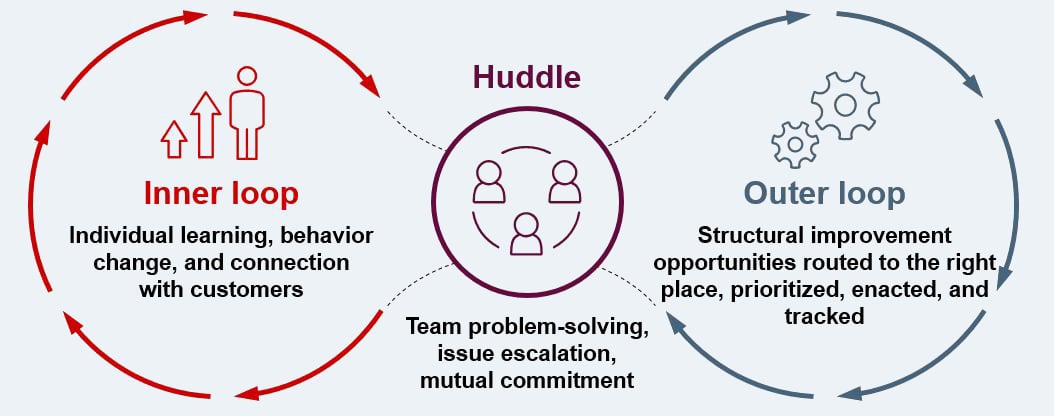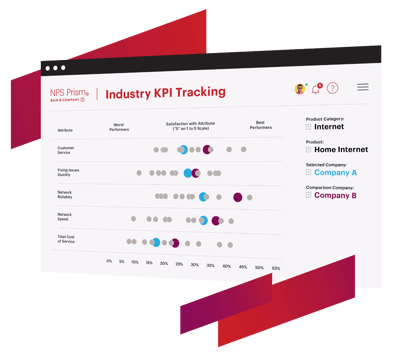How To Build An Effective Voice of the Customer Program

What Is the Voice of the Customer?
The Voice of the Customer (VoC) is an element of customer experience (CX) that summarizes customers’ feedback about their experiences with your organization, products and services. It’s focused on understanding and acting upon customer needs, expectations and preferences.
What Is a Voice of the Customer Program?
Voice of the Customer or VoC programs solicit and collect customer feedback related to specific experiences. A VoC program may focus on certain aspects of your company’s products, services or solutions. It may also center around specific customer goals, expectations or touchpoints within a journey.
A Voice of the Customer program helps you gather critical insights into how customers perceive your organization and how they feel about their experiences with it. The goal of your VoC program should be to learn more about your customers and their expectations, so you can better align your customer experience strategies around them.

Today, VoC programs leverage innovative technology like artificial intelligence (AI) and machine learning to help brands collect and analyze customer feedback data at scale, allowing your company to identify trends, opportunities, and risks across your entire customer base.
Equipped with timely, meaningful VoC insights, your organization can make informed decisions about the future of your CX strategy — providing customers with experiences that perfectly align with their expectations and business needs.
Why Is a Voice of the Customer Program Important?
In the past, businesses made assumptions about customers’ needs and preferences based on which products and services they purchased most frequently. And while this data gave organizations some insight into market demands, it didn't provide much insight into why some products succeeded — or failed — or how customers felt about the products or services they ultimately purchased.
VoC programs help your organization get timely, direct feedback from your customers. Customer feedback can help you understand what’s working well, where you have opportunities to improve, and which areas of your customer experience are most impactful to your end users.
These insights come together to improve visibility and give your marketing, sales and service teams the power to make informed decisions and measurable changes across customers' journeys.
A Voice of the Customer program will help your organization:
- Win and retain more customers
- identify points of friction or customer dissatisfaction
- Understand key elements of your customer journey
- Improve product and service development
Three Reasons to Prioritize Voice of the Customer

How to Build a Voice of the Customer Program
Customer feedback can transform your CX strategies and accelerate growth, but only if you have an effective Voice of the Customer program in place to capture, consolidate and prioritize it. Creating a VoC program for your organization requires more than an impressive VoC software implementation.
Your teams must also embrace the value of customer feedback and buy into your VoC program — including your plans for acting on the insights it uncovers.
Ways to Ensure Your Program Is Set Up
for Success From Day One
Establish A Clear Vision
Your VoC program can unite everyone behind a common goal, but only if you have a vision statement that communicates that goal clearly and concisely. Start by creating a vision statement for your VoC program that conveys what your program should accomplish.
Steer clear of too-vague statements like, “we’re aiming to gather customer feedback.” Instead, tie your vision to a business outcome with something like: “We’re aiming to increase customer retention rates by learning more about our customers and improving their experiences with our brand.”
Gain Team Buy-In
VoC programs often originate in the marketing departments, but organization-wide employee engagement can help take your VoC program from functional to transformational.
Once you establish a mission statement, start with gaining buy-in from leadership, then focus on bringing in other teams within your organization. The best way to get other teams on board is to highlight the specific, tangible benefit that team could gain from a VoC program.
For example, if you're speaking with your sales team, you might point out how a VoC program will enable them to be more efficient and effective at selling to prospects once they're armed with information on what the biggest drivers of customer satisfaction are.
Tap Into Multiple Channels
Your customers’ preferences are complex and ever-changing. This includes preferences about how they share feedback with you or interact with your team. Different customers prefer to provide feedback in different ways, all of which should be accounted for in your VoC program.
Expand your listening strategy across multiple channels, like live chat, email, and text. Look for a VoC software platform that allows you to move seamlessly between channels to meet various customers’ preferences, making it as convenient as possible to gather their invaluable feedback.
Align on Next Steps
To see a measurable impact from your VoC program, your organization must chart a clear path from customer feedback analysis to customer experience improvement.
Your VoC program should address how you’ll follow up on customer feedback, including root cause analysis, to understand which insights you should take action on. Your next steps should include more than an impressive analysis of the feedback you’ve collected; you’ll also want to use your learnings to inform change.
Identify each team’s role in follow-up actions, such as which support team members should reach out about negative feedback or which manager is responsible for implementing process improvements that result from VoC insights.
Commit to Your VoC Program
Implementing an effective Voice of the Customer program is a continuous effort, not a one-and-done project.
To achieve true customer centricity, your organization should take an iterative approach to customer feedback analysis and resulting CX improvements.
As you design, implement and iterate on your VoC program, remember your commitment to your customers and your company’s success. Encourage patience and remind leadership teams of the long-term benefits your organization will gain from a successful VoC program.
Establish A Clear Vision
Your VoC program can unite everyone behind a common goal, but only if you have a vision statement that communicates that goal clearly and concisely. Start by creating a vision statement for your VoC program that conveys what your program should accomplish.
Steer clear of too-vague statements like, “we’re aiming to gather customer feedback.” Instead, tie your vision to a business outcome with something like: “We’re aiming to increase customer retention rates by learning more about our customers and improving their experiences with our brand.”
Gain Team Buy-In
VoC programs often originate in the marketing departments, but organization-wide employee engagement can help take your VoC program from functional to transformational.
Once you establish a mission statement, start with gaining buy-in from leadership, then focus on bringing in other teams within your organization. The best way to get other teams on board is to highlight the specific, tangible benefit that team could gain from a VoC program.
For example, if you're speaking with your sales team, you might point out how a VoC program will enable them to be more efficient and effective at selling to prospects once they're armed with information on what the biggest drivers of customer satisfaction are.
Tap Into Multiple Channels
Your customers’ preferences are complex and ever-changing. This includes preferences about how they share feedback with you or interact with your team. Different customers prefer to provide feedback in different ways, all of which should be accounted for in your VoC program.
Expand your listening strategy across multiple channels, like live chat, email, and text. Look for a VoC software platform that allows you to move seamlessly between channels to meet various customers’ preferences, making it as convenient as possible to gather their invaluable feedback.
Align on Next Steps
To see a measurable impact from your VoC program, your organization must chart a clear path from customer feedback analysis to customer experience improvement.
Your VoC program should address how you’ll follow up on customer feedback, including root cause analysis, to understand which insights you should take action on. Your next steps should include more than an impressive analysis of the feedback you’ve collected; you’ll also want to use your learnings to inform change.
Identify each team’s role in follow-up actions, such as which support team members should reach out about negative feedback or which manager is responsible for implementing process improvements that result from VoC insights.
Commit to Your VoC Program
Implementing an effective Voice of the Customer program is a continuous effort, not a one-and-done project.
To achieve true customer centricity, your organization should take an iterative approach to customer feedback analysis and resulting CX improvements.
As you design, implement and iterate on your VoC program, remember your commitment to your customers and your company’s success. Encourage patience and remind leadership teams of the long-term benefits your organization will gain from a successful VoC program.
Understanding the Voice of the Customer Program Methodology
If you’ve ever been asked, “Did you find everything you were looking for today?” at the grocery store or another retail establishment, you’ve likely participated in a VoC program, whether you realized it at the time or not.
Each customer interaction allows brands to gather feedback and insight into their experiences, expectations, and loyalty. To see results from your company’s VoC program, you need to capture that feedback systematically through the collection methods that complement your business needs and your customers’ preferences.
The Voice of the Customer methodology refers to the tactics an organization uses to collect feedback from customers, including everything from sending out automated surveys to hosting focus groups or reaching out via email.
A good VoC methodology encompasses multiple feedback collection tactics, including active and passive methods. In many cases, organizations will employ several methodologies in tandem to give their customers several options and allow customer experience teams to gather different types of feedback across channels.

Eight Methods For Collecting
Voice of the Customer Feedback
Here are some of the most common tactics and methodologies you can use to start collecting VoC feedback

How to Develop a Successful Voice of the Customer Analysis Program
No matter the specific outcomes you want to achieve through VoC, your primary goal should be to understand how your customers perceive and interact with your brand, products and services.
A Voice of the Customer analysis program can help you gain this understanding through data-driven insights and actionable strategies. When done correctly, your VoC analysis program will boost customer loyalty, brand reputation and customer experiences across touch points.
The components of an effective VoC analytics program:
-
Structured feedback collection
-
Robust data analysis
-
Comprehensive action planning
There are several steps you should take to align your customer experience team and larger organization behind these elements and create a strong foundation for your VoC analysis program.
Here’s how to get started:
Identify Your Research Question
Your Voice of the Customer analysis program should help your organization answer critical CX questions. Before analyzing feedback, consult with your colleagues and stakeholders to identify the question(s) you want to answer through VoC. It might be something relatively specific, like:
-
Why were European sales of our mid-tier wireless plan down last quarter?
-
What changes should we make to the pre-flight experience for loyalty members?
-
How can we make online booking more convenient for our customers?
If you aren’t sure exactly what to ask, try zooming out a bit. Think about the most critical questions or unknowns that exist across your organization.
“This product isn’t selling like we thought it would. Can we see what customers are saying about it?"
Consider your business goals and what insights would help inform your path toward them. Distill your question down to the heart of your VoC program. Ask yourself: What information from our customers would help us improve our business?
Each question will dictate the data you gather and how you analyze it, so it’s essential to complete this step before you begin parsing through survey results or open-ended feedback responses.
Gather and Prepare Your Data
With your research question(s) in hand, it’s time to start gathering customer feedback. Start with question, then identify which types and channels would be the best source of that information.
For example, you might aim to answer a question about brand perception by reading through online reviews or social media mentions, but gather CSAT or NPS survey responses to answer a product-focused question.
No matter which collection methods you use, the feedback you gather will likely fall into one of three categories:
-
Direct feedback comes from customers who provided direct input when they knew your organization was listening — like through a survey, complaint form, interview or discussion panel.
-
Indirect feedback comes from customers who spoke about your organization without necessarily speaking to it directly. Think social listening, online reviews and text analytics of support interactions.
-
Inferred feedback comes from behavioral and operational data associated with various customer experiences. Inferred feedback is often pulled from site data, purchase history or your contact center.
In many cases, it's beneficial to collect data points across several methodologies, customer types, and feedback categories. The more varied your customer feedback data, the more likely you are to uncover unique responses that will help your organization better understand CX wins and opportunities.
Once you’ve gathered, organized and contextualized your VoC data, it’s time to conduct an in-depth analysis of your findings.
Analyze Your Results
Certain types of data require (or enable) different types of Voice of the Customer analysis. Depending on the type of data you collected, you might complete a statistical analysis of NPS, CSAT or CES scores or use text analytics to identify content themes within open-ended survey feedback.
Common VoC Analysis Tactics
-
Statistical analysis
-
Topic analysis
-
Sentiment analysis
-
Natural language processing (NLP) via text analytics
-
Data correlation
To determine the best method of analysis, you’ll need to consider both your primary research question and the type of data you’ve collected. Qualitative data lends itself to different analysis techniques than quantitative insights. And even then, small numbers of quantitative data has different analysis options than large numbers of quantitative data.
Develop an Attainable Action Plan
Some findings will lend themselves to an immediate course of action. For instance, if you uncover a glaring concern with a specific product or customer journey, you’ll likely invest the necessary resources to correct it quickly and follow up with the affected customers.
In less urgent situations, your organization can still create a roadmap to address both negative and positive feedback in service to its customers.
Expect to walk away with a mix of quick wins — like adding more signage to your lobby or parking lot — and long-term initiatives, like auditing and redesigning your mobile app to eliminate your customers’ most pressing pain points.
No matter your specific action items, it’s essential to close the feedback loop with your customers, whether they made glowing remarks or call out several hard truths. Every action plan should include internal and external follow-up components.
Internally, you might adjust your sales outreach process to fit customers’ communication preferences. Externally, you should follow up with the customers who provided feedback on your current sales outreach initiatives, letting them know you received their feedback and telling them how you plan to refine the process.
Turn Feedback Into Learning Opportunities
The methodology at the heart of Bain & Company’s Net Promoter System leverages the "inner loop," "huddle," and "outer loop" to help organizations turn customer insights into business impacts.
You should implement this same methodology across its entire VoC program to ensure customers see the impact of the feedback they’re providing, both in direct and indirect interactions with your team.
-
The inner loop promotes individual learning and helps employees enhance relationships with customers by exposing them to customer feedback and giving them the opportunity to follow up appropriately.
-
The outer loop helps organizations prioritize and support customer-centric changes individual contributors can’t make on their own by routing customer feedback to the appropriate decision-makers.
-
Huddles keep teams across all levels of an organization focused on customer-friendly initiatives through concise, routine meetings where the inner and outer loops converge.

An effective Voice of the Customer program doesn't just collect customer insights — it turns them into an actionable customer experience strategy.
How to Use Voice of the Customer Insights to Improve Customer Experience
If implemented correctly, regardless of what your ultimate questions are, VoC programs should make your customers’ experiences more convenient, personalized, and on par with (or above) their expectations.
You can use newly uncovered Voice of the Customer insights to improve customer experiences by:
Uncovering Unexpected Insights and Opportunities
VoC programs often uncover answers to questions you haven’t even asked yet, paving the way for meaningful further research and opening up new opportunities to improve your customer experience.
For instance, you might create a feedback survey implicitly designed to help you determine which grocery store products to discount for loyalty club members, only to come across recurring feedback around a glitch in your store’s mobile app.
Surprise findings like this can help you uncover new ways to delight your customers based on their genuine feedback about your business.

Revealing Customers’ Preferences
Voice of the Customer data enables you to identify and mitigate less-than-ideal experiences across your organization. However, it’s also a great way to learn more about your customers’ likes and dislikes, so you can deliver experiences that don’t just meet expectations but exceed them.
Survey responses, online reviews and support tickets give your customer experience team real-world insight into customers’ preferences — insight you can use to inform how you interact with those specific customers and customers like them moving forward.
So if you learn from VoC data that one of your customers prefers communicating over email and receiving personalized check-ins from their account manager, add those notes to their record in your CRM to be sure your colleagues honor them in future interactions.
Enhancing Customer Journeys
Voice of the Customer feedback can help you tap into CX opportunities at every level of your organization, from overall satisfaction to individual customer journeys.
When collecting VoC feedback, you’ll want to pose research questions that address customers’ experiences and journeys at a granular level.
So while relationship NPS and CSAT surveys that ask, “how likely are you to recommend us to a friend or colleague?” are essential, your organization should also ask for more granular feedback about specific experiences.
Implementing a combination of relationship-level and episode-level VoC collection tactics will ensure your VoC program captures a wide range of customer feedback and uncovers actionable CX opportunities that are tied to specific journeys, not just overall sentiment.
Getting Ahead of Potential CX Shortfalls
A successful VoC program empowers customer experience and support teams to resolve customers’ concerns and improve misaligned experiences, but it also gives them the insights they need to take a proactive approach to their CX strategies.
You can use VoC analytics to identify patterns and trends within your customers’ experiences and your company’s service delivery activities. By looking back at what went wrong in the past, you’ll be able to better anticipate and prevent similar issues from occurring in future customer interactions.
For instance, let’s say your latest NPS survey data revealed that 40% of your customers saw a significant dropoff in communications 90 days after onboarding. With that data in hand, you could develop a check-in plan for your customer success team that remind reps to check in with new customers on a bi-weekly basis for the first six months of their engagement.

Voice of the Customer
Best Practices
A Voice of the Customer strategy should go beyond your choice in analytics software or answering the core questions you posed when developing your VoC program.
While a reliable tech stack and clear vision are both integral to success, you must also consider how all the elements of your VoC initiatives fit together to provide you with a complete picture of your customer experience. Then, how your organization uses those findings to inform team learning, organizational improvement, and end-user experiences.
Your VoC program should focus on cross-functional collaboration, holistic improvement and, above all else, customer centricity. To achieve these outcomes, you’ll need to align your organization behind several Voice of the Customer best practices.
Share Feedback Across Your Enterprise
One central team might champion your Voice of the Customer program, but they shouldn’t be the only ones exposed to the insights it uncovers.
As you learn more about your customers through VoC, increase the visibility of your findings across teams and departments. You can even look for opportunities to collaborate with sales, service and success teams to action on VoC insights and set shared goals for improving customer sentiment.
Respond to Customer Feedback
It can be tempting to turn straight from VoC data analysis to your full-scale action plan for CX enhancements. And while it’s important to apply your learnings to an overarching CX strategy, be sure the customers who provided you with that all-valuable feedback don’t get lost in the shuffle.
Establish a formal follow-up process to close the loop with customers who submitted feedback, whether they sang your praises or shared some hard truths. They’ll appreciate your thanks, acknowledgment of receipt or attempts to make things right.
Seek Feedback at the Right Time
Timing is everything, especially when it comes to gathering feedback on customers’ (sometimes emotional) experiences with your brand. You don’t want to wait so long that customers barely remember their interaction with your company or think you’ve forgotten them, but you don’t want to overwhelm them with too many feedback requests too quickly, either.
Harness the power of automation to scale and solicit feedback at the right time within a customer journey, like sending out a feedback survey after someone makes an online purchase.
Personalize Feedback Requests
Soliciting feedback is all about making your customers feel heard and appreciated. Well-composed feedback requests include a human touch that reminds your customers that you see them as real people, not numbers on a list of accounts.
Automation can also help you personalize feedback requests with customers’ personal details — like their name or company name — and some references to their unique experiences with your brand.
For example, instead of the generic-sounding, “How was your customer service experience today?” opt for something a little more personal like, “Hi, [name]. Thanks for contacting us today. Did [team member] answer your questions to your satisfaction?”
Use Your Findings to Inform Decisions
The most impactful element of your VoC program is how you use the findings you uncover. VoC analysis equips your business with trustworthy, real-world insights that eliminate internal debates and pave the way for informed decision-making.
Rather than taking your best guess at what customers want or need, you’ll be able to turn real feedback into a strategy that will delight your customers and deliver results for your business.
Bring customer feedback, analyses and trends to conversations with your CX team and other stakeholders across your organization, and use these findings to inform changes to your customer experience and other business processes.
Share Feedback Across Your Enterprise
One central team might champion your Voice of the Customer program, but they shouldn’t be the only ones exposed to the insights it uncovers.
As you learn more about your customers through VoC, increase the visibility of your findings across teams and departments. You can even look for opportunities to collaborate with sales, service and success teams to action on VoC insights and set shared goals for improving customer sentiment.
Respond to Customer Feedback
It can be tempting to turn straight from VoC data analysis to your full-scale action plan for CX enhancements. And while it’s important to apply your learnings to an overarching CX strategy, be sure the customers who provided you with that all-valuable feedback don’t get lost in the shuffle.
Establish a formal follow-up process to close the loop with customers who submitted feedback, whether they sang your praises or shared some hard truths. They’ll appreciate your thanks, acknowledgment of receipt or attempts to make things right.
Seek Feedback at the Right Time
Timing is everything, especially when it comes to gathering feedback on customers’ (sometimes emotional) experiences with your brand. You don’t want to wait so long that customers barely remember their interaction with your company or think you’ve forgotten them, but you don’t want to overwhelm them with too many feedback requests too quickly, either.
Harness the power of automation to scale and solicit feedback at the right time within a customer journey, like sending out a feedback survey after someone makes an online purchase.
Personalize Feedback Requests
Soliciting feedback is all about making your customers feel heard and appreciated. Well-composed feedback requests include a human touch that reminds your customers that you see them as real people, not numbers on a list of accounts.
Automation can also help you personalize feedback requests with customers’ personal details — like their name or company name — and some references to their unique experiences with your brand.
For example, instead of the generic-sounding, “How was your customer service experience today?” opt for something a little more personal like, “Hi, [name]. Thanks for contacting us today. Did [team member] answer your questions to your satisfaction?”
Use Your Findings to Inform Decisions
The most impactful element of your VoC program is how you use the findings you uncover. VoC analysis equips your business with trustworthy, real-world insights that eliminate internal debates and pave the way for informed decision-making.
Rather than taking your best guess at what customers want or need, you’ll be able to turn real feedback into a strategy that will delight your customers and deliver results for your business.
Bring customer feedback, analyses and trends to conversations with your CX team and other stakeholders across your organization, and use these findings to inform changes to your customer experience and other business processes.
Choosing the Right Voice of the Customer Tools
Now that we’ve covered the value of customer feedback, methods you might use to collect it and how you can leverage your findings, let’s discuss another essential part of your VoC program: the tools you’ll use to bring it to life.
As the name suggests, your Voice of the Customer tools are the systems and processes you’ll use to collect and analyze customer feedback. They make it possible to solicit and gather feedback through the many tactics shared above — from streamlining the NPS survey process to helping you identify common themes in online reviews.
Every organization’s VoC software solution will look a bit different depending on their preferred feedback channels, existing tech stack, customers’ preferences and more. Still, there are several crucial VoC tools you should consider adding to your customer experience arsenal.
Tap into Powerful Voice of the Customer Data With NPS Prism
NPS Prism’s powerful NPS benchmarking platform enables you to make informed CX decisions by uncovering real-world insights directly from your NPS scores, your customers and your competitors’ customers. Our platform’s data collection and analysis tools are designed to complement your existing VoC tools, whether you’ve built an in-house program or purchased foundational VoC software.
Built on Bain & Company’s tried-and-tested research methodology, NPS Prism shows you how your NPS scores compare to competitors in your industry. It also uncovers clear, up-to-date insights from open-ended NPS responses to help you make impactful customer experience improvements using real feedback from your customers and your competitors’ customers.
Leverage NPS leaderboards to benchmark your NPS scores against competitors and monitor industry trends over time. Tap into KPI tracking and custom dashboards to continually monitor and improve the customer experiences that matter most to your business — and your customers.
NPS Prism’s data is backed by Bain & Company research and updated regularly to ensure your benchmarking analyses always reflect the latest insights from your industry and your customers.



